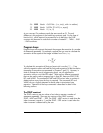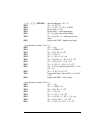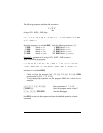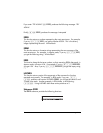
Page 21-59
J1 # 1.5 # 0.5 ` Enter parameters 1 1.5 0.5
[ ‘ ] @GLIST ` Enter the program name in level 1
„°LL @)@RUN@ @@DBG@ Start the debugger.
Use @SST↓@ to step into the program and see the detailed operation of each
command.
The FOR construct
As in the case of the START command, the FOR command has two variations:
the FOR…NEXT construct, for loop index increments of 1, and the FOR…STEP
construct, for loop index increments selected by the user. Unlike the START
command, however, the FOR command does require that we provide a name
for the loop index (e.g., j, k, n). We need not to worry about incrementing the
index ourselves, as done in the examples using START. The value
corresponding to the index is available for calculations.
Commands involved in the FOR construct are available through:
„°@)@BRCH@ @)@FOR
Within the BRCH menu („°@)@BRCH@) the following keystrokes are available
to generate FOR constructs (the symbol indicates cursor position):
Θ „ @)@FOR: Starts the FOR…NEXT construct: FOR NEXT
Θ ‚ @)@FOR: Starts the FOR…STEP construct: FOR STEP
The FOR…NEXT construct
The general form of this statement is:
start_value end_value FOR loop_index program_statements
NEXT


















